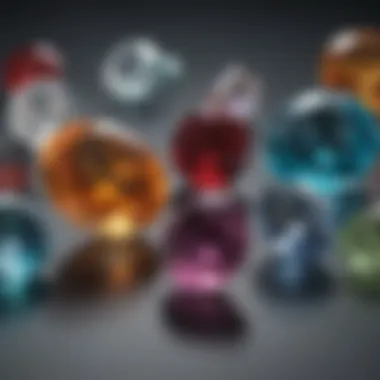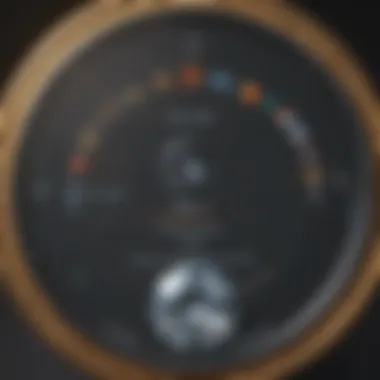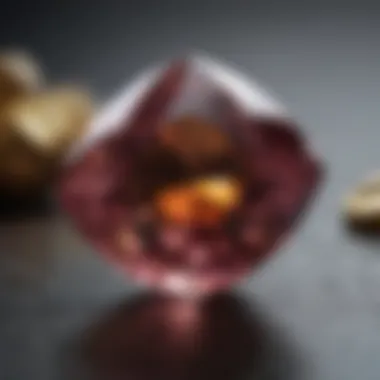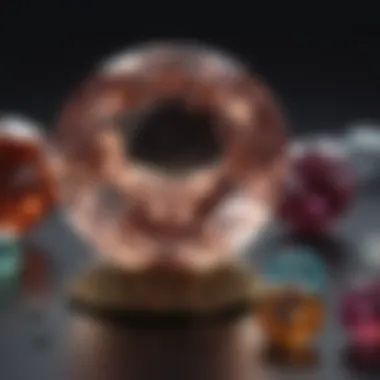Understanding Carat Weight: Size and Measurement Insights


Intro
When we think about gemstones, what often comes to mind is sparkle, rarity, and beauty. Yet, there’s a layer beneath those surface attributes that demands attention: carat weight. This measurement not only plays a significant role in determining a gem’s value but also affects how we perceive its size. In this guide, we are diving into the realms of gemstones and their carat weight, unraveling its mysteries and nuances while ensuring we unearth the practical details that every gemstone enthusiast should know.
Carat weight, fundamentally, is a standard by which gemstones are weighed, with one carat equating to 200 milligrams. But the conversation doesn't end there. The determination of a gem’s size and quality involves much more, including the conversion of these carats into physical dimensions like millimeters. As simple as it sounds, this can turn into a complex affair depending on various factors that influence a gemstone's perceived size.
Whether you are a collector, a jewelry designer, or simply someone captivated by the allure of gems, understanding carat weight is both an essential and enriching pursuit. With this guide, we aim to provide insights that will elevate your appreciation of these magnificent creations of nature.
Prolusion to Carat Weight
Understanding carat weight is pivotal for anyone involved in the world of gemstones, whether you are a collector, a designer, or simply an aficionado. Carat weight not only affects the value of a gemstone but also plays a vital role in determining its size and appearance. The nuances of this measurement resonate far beyond a mere numerical value; they involve interpreting and appreciating the very essence of the stone.
Carat weight is often the first thing that catches the eye when evaluating a gemstone. It's a crucial component in the gemstone grading process, influencing the perceptions of rarity and worth. However, it is essential to recognize that carat weight does not paint the complete picture. Factors like cut, clarity, and color also play critical roles in assessing a stone’s overall value.
When diving into the world of carat weight, one ought to consider various elements, such as how the specific weight translates into size. Varying densities of gemstones mean that two gems with the same carat weight might differ significantly in size. For instance, a one-carat diamond could appear smaller than a one-carat aquamarine due to their distinct densities. This distinction makes it vital for gem enthusiasts to grasp the broader significance of carat weight, as it interlinks with the physical dimensions of a gemstone.
In this article, we will elaborate on the various facets of carat weight, including its historical context and technical definitions. We'll also explore how carat weight translates to visible size and its relationship with the holistic evaluation of gemstones. Ultimately, our goal is to empower readers with knowledge—enabling them to make informed decisions when appreciating or purchasing gems.
"Carat weight is the first glance, but the quality of the gem makes it shine."
Let's begin with the fundamental understanding of what a carat actually is.
Definition of Carat
A carat is a unit of weight used specifically for gemstones and pearls, equal to 200 milligrams (or 0.2 grams). The term originates from the carob seeds that ancient jewelers used as balances for weighing precious stones. Though the practice has evolved over the years, the essence of using a standard unit remains intact.
At its core, the carat determines the weight, not the size or beauty, of the gemstone. Therefore, a higher carat weight usually corresponds to a more substantial stone, which generally means higher value. However, it’s crucial to understand that just because a stone is heavier doesn’t guarantee it’s the most desirable. As indicated earlier, the cut and clarity significantly influenced the perceived attractiveness of a gemstone.
Historical Context of the Carat
The historical context of carat measurement provides fascinating insights into the world of gemstone trading. The carat as a unit of measurement can be traced back to the Byzantine Empire. It is said that traders employed carob seeds because they were relatively uniform in weight.
Over centuries, the trading of gems propelled various cultures to standardize the carat measure, leading to the modern system we adhere to today. In fact, the International System of Units (SI) recognizes the carat as an approved unit of mass, paving the way for universal acceptance.
The importance of standardization cannot be overstated. It helps prevent confusion, ensuring that gem buyers are making informed purchasing decisions. Without a standard measure, gemstone values could vary dramatically, leading to disputes and misunderstanding in the market.
In summary, the understanding of carat weight is not just a matter of precision; it is intimately intertwined with the history of trade, culture, and gemology itself. With that context, we can now examine how carat weight translates into actual gemstone size.
Carat to Millimeter Conversion
Understanding the conversion of carat weight to millimeter measurements is crucial for anyone involved in the gemstone industry, whether you’re a collector, a jewelry designer, or a geology enthusiast. Carat weight is often used as a primary indicator of a gemstone's value; however, buyers also want to know how that weight relates to physical size. While two gemstones may share the same carat weight, their dimensions can vary immensely, influenced by factors like cut and shape. Therefore, mastering the conversion helps to gauge a gem’s visual impact more accurately.
When one understands the various aspects of carat and how it translates to millimeters, it opens doors to making more informed purchases and evaluations. It’s like knowing the difference between a good seat and an excellent one at a concert; both give you a view, but one gives you a view worth the ticket price.
Understanding the Conversion Process


The conversion from carats to millimeters isn’t as straightforward as it appears. Each gemstone has its own unique density and refractive index, which affects how light interacts with it, ultimately influencing how its size is perceived. The basic principle goes as follows: a carat is a unit of weight equivalent to 200 milligrams. However, what’s critical to note is that the millimeter measurements will not always correspond directly to the carat weight due to the aforementioned factors.
For example, a round brilliant diamond with a carat weight of 1 carat typically measures about 6.5 mm in diameter. However, if you're dealing with a sapphire of the same weight, it might measure slightly smaller due to its denser composition. To effectively convert carat weight into millimeters, consider using geometric formulas or online conversion tools that factor in specific gemstone types.
"Conversion isn’t just about numbers; it’s about understanding the underlying properties that dictate what those numbers mean."
Standard Conversions for Various Gemstones
Here’s a brief dive into typical conversions from carats to millimeters, tailored for various popular gemstones:
- Diamonds: 1 Carat = Approximately 6.5 mm in diameter.
- Emeralds: 1 Carat = About 7 mm for an oval or rectangular cut.
- Sapphires: 1 Carat = Roughly 6 mm in diameter, although this can vary by shape.
- Rubies: 1 Carat = Approximately 6.5 mm, similar to diamonds in round cuts.
These measurements can serve as a benchmark, though adjustments may be necessary based on the stone's unique characteristics. Ultimately, when assessing the value and appeal of a gemstone, keeping these conversions in mind allows you to appreciate its beauty in a whole new light.
Understanding how carat translates to millimeter dimensions in gemstones equips you with a richer grasp of their worth, aesthetics, and even emotional resonance. Every gem tells a story, but knowing its size starts with understanding its weight.
The Relationship Between Carat Weight and Size
Understanding the relationship between carat weight and the size of gemstones is like fitting together pieces of a puzzle. For gem enthusiasts, collectors, and even casual shoppers, this connection is crucial. Carat weight often dictates how a stone will be perceived in a jewelry setting. This perception can sway decisions about purchases and investments. It is essential to grasp that while carat weight is a significant factor, it is not the sole rule defining size.
How Carat Weight Influences Size
When we discuss how carat weight impacts size, we need to recognize that one carat equals 200 milligrams. A larger carat weight typically indicates a bigger stone; however, the size you see is not just about the weight alone. This weight could translate differently into physical dimensions, depending on the stone type. For instance, a one-carat round diamond will have a different diameter than a one-carat emerald due to variations in density and shape.
Moreover, it’s good to note that gemstones that are more dense, like sapphires, will appear smaller at the same carat weight than less dense stones such as quartz.
Here’s a brief look at how diverse gemstones present their sizes, despite having the same carat:
- Diamond: Round diamonds optimize light, making them appear larger than their actual size.
- Emerald: The cut and depth of an emerald can make it seem denser, providing a bulkier appearance without the corresponding carat weight.
- Topaz: This stone, with its lighter density, can appear larger even at lower carat weights.
Understanding these nuances helps buyers make informed choices, allowing them to appreciate why one carat can look so different on various gemstones.
Size Perception Among Different Gemstones
Perception plays a vital role in how size is interpreted. Different gemstones can create an illusion of size that differs from their actual measurements. The collective influence of factors like cut, clarity, and overall visual appeal cannot be overlooked. When it comes to perception:
- Color can trick the eye; darker stones often appear smaller.
- Shape: Long, oval-shaped gems can easily give off the impression of being larger than a round stone of the same weight.
- Placement: In a piece of jewelry, how a gemstone is set can affect perceived size. A setting that elevates the stone can help it catch the light better, enhancing its apparent size.
In summary, when comparing gemstones, it is essential to consider that true size perception is a blend of multiple factors, not just carat weight.
The Role of Cut in Size Appearance
The cut of a gemstone is arguably one of the most profound factors affecting how large a stone appears. Each cut has a unique way of reflecting light, which can amplify or diminish the perception of size.
For instance:
- A well-cut round diamond exhibits brilliance and sparkle, making it appear larger than a poorly cut one of the same weight.
- Fancy cuts, such as marquise or pear shapes, can elongate the appearance, giving a sense of size without the actual weight.


"A gem's cut can make it sing or silence its appeal entirely; thus, choose wisely."
Moreover, facet arrangements influence how light interacts with a stone. The better the facets are crafted, the more the stone can shine, emphasizing its size in a captivating manner. In this way, cut becomes not only a matter of aesthetics but also of perceived size.
Understanding how carat weight relates to size allows gem collectors and jewelry enthusiasts to appreciate the inherent qualities of each stone. It encourages informed choices that go beyond numbers, capturing the beauty and essence of every gem.
Quality Factors in Gemstones
When it comes to gemstones, understanding the quality factors is crucial for any enthusiast or designer. The quality of a stone does not simply hinge on its carat weight; rather, it encompasses a variety of aspects that influence its overall value and attractiveness. Knowing these factors can significantly aid in selecting a gemstone that not only meets aesthetic desires but also bears intrinsic value for collection or investment.
Understanding Clarity and Color
Clarity refers to the presence of internal flaws, or inclusions, within the gemstone. Every stone has its own story, encapsulated within these natural imperfections. A clearer stone, with fewer inclusions, is often more valuable. However, it’s vital to understand that some inclusions can also add character and even uniqueness, making them more desirable to certain collectors.
- Types of Clarity:
- Flawless (F): No inclusions or blemishes visible under 10x magnification.
- Very Very Slightly Included (VVS): Minute inclusions that are difficult to see under magnification.
- Very Slightly Included (VS): Minor inclusions visible under magnification but not to the naked eye.
- Slightly Included (SI): Inclusions visible to the naked eye, but they do not significantly hinder the stone's beauty.
- Included (I): Inclusions visible without magnification, often affecting transparency and brilliance.
Color is another pivotal factor affecting a gemstone's desirability. The hue must be vibrant, and saturation should be rich without any dull undertones. Different stones have their distinct color characteristics. For instance, the deep blue of a sapphire can be striking, while the vivid green of an emerald captivates with its lushness.
"Color, alongside clarity, forms the backbone of a gemstone's identity. A radiant hue often bewitches the beholder and elevates a stone’s status."
Scoring the balance between these aspects is essential for gem lovers. Some stones, like red rubies, can command high prices even if they don’t score perfectly on the clarity scale, simply due to their captivating color.
Impact of Cut on Value and Size
The cut of a gemstone plays an influential role in its overall quality, perhaps even more than many realize. A well-executed cut can enhance a gemstone's brilliance, creating an interplay of light that heightens its visual appeal. Poor cuts can diminish value drastically, regardless of the stone's potential. Moreover, the cut affects the perceived size of a gem, which is significant for many buyers.
- Common Types of Cuts:
- Brilliant Cut: Maximizes shine; typically seen in diamonds.
- Emerald Cut: Often used for emeralds and other colored gems, known for larger facets that emphasize clarity.
- Princess Cut: A modern, square cut that offers a fresh allure.
The relationship between cut and value is complex. A well-cut stone can appear larger, thanks to optimal light reflection. In contrast, a bad cut may make a larger stone look small and lifeless.
Ultimately, understanding how clarity, color, and cut interact with carat weight provides a holistic view of gemstone selection. Just as the right outfit can make an individual shine, choosing a gem with the perfect balance of these qualities can elevate any piece of jewelry to a whole new level.
Practical Guidelines for Gem Enthusiasts
When it comes to stepping into the world of gemstones, practical information can be worth its weight in gold. The guidelines discussed in this section aim to enhance the experience of gem enthusiasts, collectors, and jewelry designers. Understanding the nuances of gemstone sizes, values, and quality can empower you in making informed choices. The importance of these guidelines cannot be overstated, as they help you navigate through the often overwhelming world of gemstones with ease.
Choosing the Right Size for Jewelry
Finding the right size gemstone for your jewelry piece isn't just about personal preference; it's about harmony and proportion. Ideally, the size of the gemstone should complement the design of the jewelry. Here are several considerations to keep in mind:
- Personal Style: Think about the wearer’s tastes. Some may prefer bold, statement pieces, while others may lean towards subtle elegance. Matching the size of the gem to the style of the jewelry is key.
- Setting: The choice of setting greatly influences how size is perceived. For instance, a large stone in a delicate setting can seem out of place. Conversely, a smaller gem in a lavish setting may appear lost.
- Occasion: Is it for an everyday piece or a special event? A larger gem may shine at a wedding but feel excessive for casual wear.
- Comfort: A gemstone that feels too large or heavy can be uncomfortable. Keep in mind that ease of wear should not be sacrificed for visual impact.


The balance between size and wearability is crucial. Larger gems can often dazzle, but if they are impractical for daily use, they might sit unworn in a drawer.
Evaluating the Overall Value of a Gemstone
Determining the value of a gemstone goes beyond merely noting its carat weight or size. Several factors contribute to a gemstone's worth:
- Quality Attributes: Clarity, cut, and color all play significant roles. A well-cut stone may appear larger and more brilliant than a heavier stone with poor cut quality.
- Market Trends: As any savvy collector will tell you, market demand can shift quickly. Familiarizing yourself with current trends, whether through online forums or local jewelers, can give insights into what might appreciate in value over time.
- Certification: Always seek out reputable grading reports from recognized gemological laboratories. Documents from institutes like the Gemological Institute of America (GIA) add a layer ofTrust and authenticity to any purchase.
- Historical Significance: Sometimes, a piece’s backstory or previous ownership can elevate its value exponentially. This is especially true in cases involving rare stones or pieces created by renowned jewelers.
"When evaluating the value of a gemstone, remember: it’s not just about the stone itself, but about the story it tells."
Understanding what affects gemstone value can also help in setting reasonable expectations. In summary, well-informed choices, grounded in practical guidelines, can significantly enhance both your enjoyment and investment in gemstones.
Cultural Perspectives on Carat Measurement
Exploring cultural perspectives on carat measurement provides a deeper understanding of how gemstones are valued across different societies. Each culture brings its own set of beliefs, traditions, and standards that can influence what a carat means to them. For gem enthusiasts and collectors, contemplating these cultural variances enriches their appreciation of gemstones and their worth.
Different cultures interpret carat weight in varying ways, impacting how gemstones are perceived and valued. In many Western societies, larger carat weights are often synonymous with luxury and status. For instance, a diamond engagement ring typically favors larger stones, with societal norms valuing a one-carat diamond as a minimum. Conversely, in other cultures, the broader context of the gemstone's characteristics, including its color, clarity, and origin, can reframe how its size is appreciated.
Cultural Variations in Gemstone Valuation
The valuation of gemstones diverges significantly around the world. In some Eastern cultures, smaller stones that are rich in hue are preferred over larger but less vibrant ones. For example, a small, high-quality emerald or ruby might be seen as more desirable than a larger stone of lesser quality. The design of jewelry also carries cultural significance; for instance, in India, intricate designs in gold settings might catch the eye, overshadowing the raw carat weight.
Understanding value goes beyond the mere measurement; it also encompasses narratives and symbolism. In many African cultures, gemstones symbolize prosperity and heritage, with their value tied closely to community identity. This heritage can greatly affect market perceptions, leading collectors to appreciate not just the gemstones, but the stories they tell.
Historical Practices and Their Influence
Delving into historical practices illuminates how the valuation of carats has shifted over time. In the past, gemstones were not just accessories but carried significant meanings, often reflecting wealth, power, or spiritual connections. Ancient civilizations, such as the Egyptians, viewed stones not just by their size but their believed mystical properties.
As trade routes expanded, the introduction of foreign gemstones influenced local cultures and their valuations. For example, the arrival of diamonds in European markets during the 15th century altered the landscape of luxury. Before then, colored stones were often more prized than colorless diamonds. This shift initiated a long-lasting perception that remains in place today, where diamonds stand as the pinnacle of gem quality in many Western cultures.
Historical practices not only provide context but draw parallels with modern sensibilities. Understanding these traditions allows collectors to appreciate more than just a gemstone's carat weight; it encompasses a rich tapestry of human history and emotion.
Overall, cultural perspectives on carat measurement enrich our understanding of gemstones, revealing varied valences that enhance both appreciation and valuation among enthusiasts.
Ending
In summary, the discourse surrounding carat weight cannot be isolated from its cultural implications. As gem enthusiasts and collectors delve deeper into the meanings and perceptions behind gemstones, they unveil not only the intrinsic values of their stones but also the powerful stories and traditions that shape their significance.
Epilogue
Understanding carat weight is vital for anyone stepping into the world of gemstones. It’s not just about measuring size but also appreciating the craftsmanship and value embedded in each stone. This article has highlighted essential elements that contribute to the understanding of carat weight, including its conversion to millimeters, the influence of size perception, and the cultural perspectives that shape our appreciation of these precious materials.
Summarizing the Importance of Understanding Carat Weight
Carat weight serves as a standardized measure, a common language in the gemstone industry. Knowing how carats correlate to size can dramatically affect a buyer’s choice, particularly in jewelry selection. A gemstone's carat weight often directly impacts its value; as such, understanding this concept helps collectors and enthusiasts make informed decisions. Consider that a larger carat stone often carries a hefty price tag, but it is also crucial to analyze clarity, cut, and color alongside weight. Therefore, when assessing a gem, carat weight is a key factor, yet it’s never the sole consideration.
Information on carat weight clarifies perceptions, especially among those new to gems. It's easy to become entranced by larger stones, sometimes overlooking the intricacies of smaller, finely cut gems that can actually have more sparkle and brilliance. Appreciating the nuances of carat weight fosters not just knowledge but also a deeper love for gemstones, as it leads to a more holistic understanding of what makes each stone unique.
Encouragement for Continuous Learning in Gemology
Gemology is a fascinating field, brimming with continual advancements and discoveries. There is always more to learn about gemstones, from their formation in the Earth’s crust to the innovative techniques for cutting and polishing them. Expanding knowledge in this field encourages enthusiasts to delve deeper, not just into carat weight but also into the broader narrative of each stone’s journey.
Make it a habit to explore reputable resources such as books, websites like Wikipedia, or even community discussions on platforms like Reddit. By staying curious and open to new information, you allow yourself to grow not just as a collector but as a connoisseur.



